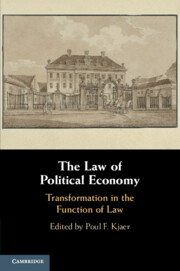Book contents
- The Law of Political Economy
- The Law of Political Economy
- Copyright page
- Dedication
- Contents
- Contributors
- Acknowledgements
- Abbreviations
- 1 The Law of Political Economy
- Part I Studying the Law of Political Economy
- 2 The Legal Proprium of the Economic Constitution
- 3 The Myth of Democratic Governance
- 4 A Political Economy of Contemporary Legality
- Part II Transformations of the Law of the Globalising Economy
- Part III The Transformation of the Law of Political Economy in Europe
- Part IV Towards a New Law of Political Economy
- Index
4 - A Political Economy of Contemporary Legality
from Part I - Studying the Law of Political Economy
Published online by Cambridge University Press: 18 April 2020
- The Law of Political Economy
- The Law of Political Economy
- Copyright page
- Dedication
- Contents
- Contributors
- Acknowledgements
- Abbreviations
- 1 The Law of Political Economy
- Part I Studying the Law of Political Economy
- 2 The Legal Proprium of the Economic Constitution
- 3 The Myth of Democratic Governance
- 4 A Political Economy of Contemporary Legality
- Part II Transformations of the Law of the Globalising Economy
- Part III The Transformation of the Law of Political Economy in Europe
- Part IV Towards a New Law of Political Economy
- Index
Summary
The chapter starts with an observation: contemporary élite jurists pursue, vis-à-vis one another, a “hermeneutic of suspicion”, meaning that they work to uncover hidden ideoogical motives behind the “wrong” legal arguments of their opponents, while affirming their own right answers allegedly innocent of ideology. The rise of the hermeneutic of suspicion is a striking manifestation of the contemporary transformation of the relationship between legal élites and political economic élites. This transformation accompanies and corresponds to the progressive juridification, judicialisation and finally constitutionalisation of the contemporary social order.
Keywords
- Type
- Chapter
- Information
- The Law of Political EconomyTransformation in the Function of Law, pp. 89 - 124Publisher: Cambridge University PressPrint publication year: 2020
- 2
- Cited by

